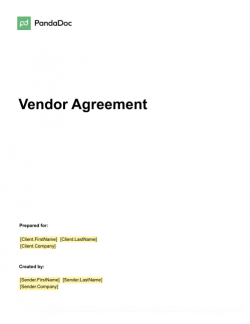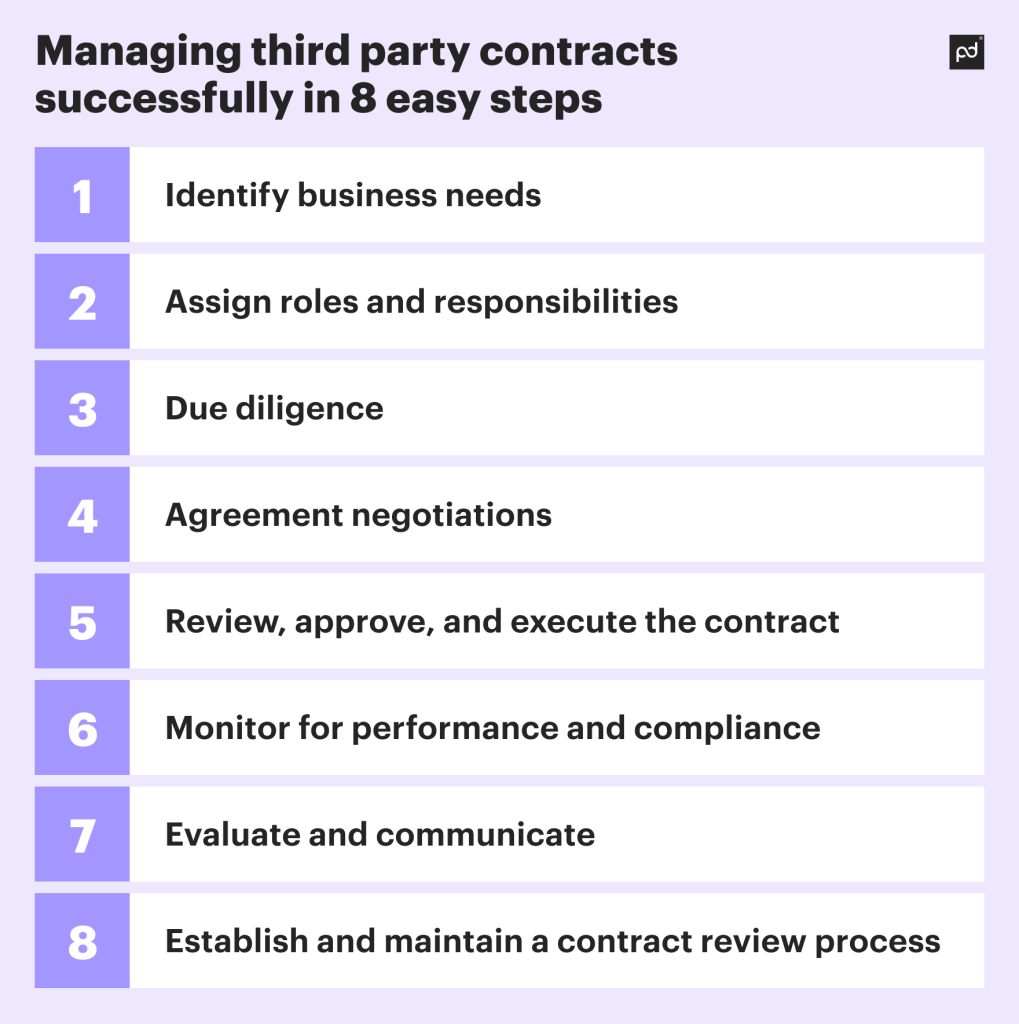Businesses continue to lean on outsourcing, but how can you best handle third party contract management?
Simply put, you can effectively manage third-party contracts by establishing clear expectations and responsibilities in the initial agreement.
Then, a centralized contract management system should be implemented to track key dates and performance metrics and facilitate regular reviews.
Lastly, you must maintain open communication, conduct periodic assessments, and update contracts as needed to ensure compliance and successful collaboration.
Business process outsourcing (BPO) had a small dip due to COVID-19 but is back on the rise.
Grand View Research predicts the global BPO market will reach $525 billion by 2030, so knowing all about the third party management process is valuable.
In this article, we will cover the following:
Key takeaways
- Third party contracts have many use cases from third party beneficiaries to service providers and vendors.
- Business process outsourcing relies heavily on third party contract management.
- Third party contract management includes negotiating terms, monitoring performance, and contract reviews.
- Contract management software like PandaDoc streamlines every step of third party agreement management.
What is a third party contract?
Third party agreements are contracts that involve a party who isn’t a “party to contract.”
Third parties have obligations, liability, or benefits bound to contract terms.
Here is how the three parties are typically identified:
- First party– company or individual that initiates the contract
- Second party– recipient of the offer (goods, services, benefits) outlined in the contract
- Third party– not a primary signatory but has associated rights and obligations tied to the agreement
When is a third party contract used?
A third party contract agreement is used in a variety of situations.
First, let’s look at the circumstances where a third party applies.
Third parties fall into three categories:
Beneficiary– A third party involved in legal recourse for contract enforcement. A typical example is life insurance. Your partner is the beneficiary of your life insurance policy. They are a primary signatory but still stand to benefit.
Assignee– One of the primary parties assigns their rights to another party. The contract-obligated party or obligor must now perform for the assignee party.
Delegate– Similar to an assignee. The delegate must now perform according to contract terms. However, the delegator still holds all liability in case of breach of contract.
Businesses and organizations draw up two kinds of contracts concerning third parties.
The first is what’s known as a third party paper or third party contract.
Unlike other situations, the counterparty creates the contract and outlines its terms.
Common management contracts in business are:
Vendor agreement – a contract between two or more parties. An additional party joins the contract later on.

Vendor Agreement Template
Used 9112 times
4.4 rating (19 reviews)
This vendor agreement template can be used by a company to ensure that new vendors are aware of the terms of doing business with their organization.
Use this templateService level agreements (SLAs) – outlines expectations for service, timelines, compliance, and penalties.

Service-Level Agreement Template
Used 6890 times
4.3 rating (35 reviews)
Adapt this Service-Level Agreement Template as a way to define a service in an official capacity.
Use this templatePartnership agreements – formalize business relationships, including roles, responsibilities, and obligations.

Partnership Agreement Template
Used 7917 times
This distribution agreement template is designed to help UK distributors accelerate their document signing process. Download your free copy today.
Use this templateThese agreements represent a way for businesses to outsource performance but not responsibility.
Both third party contracts facilitate BPO partnerships and all kinds of business transactions.
What are the disadvantages of third party contracts?
Third party contracts are best suited to specific situations. This is because, like most legal devices, they have pros and cons.
The following are the disadvantages of third party contracts:
- Increased complexity– Introducing a third party adds complexity to legal documents.
- Dependency issues– Yet another party on which your business is dependent to perform.
- Loss of control– Relying on outside parties means less control over each process.
- Potential risks– A third party to a contract might put sensitive information at risk. Additionally, a counterparty contract may offer you less protection than is needed.
- Financial losses– Not using your standard contracts can result in less profitable agreements.
- More difficult to monitor and self-serve- Monitoring third parties is challenging. The counterparty may not have easy ways for your team to self-serve on contracts.
- Take longer to review– They’re not your contact templates. You’ll spend time combing through agreements.
- Data restraints– Documents or data don’t connect to your business tools. This hurts analytics and impedes insight formation.
What is third party management?
Third party management is the process in which companies handle outsourced parties.
It’s how they communicate, negotiate, track, and enforce compliance with legally binding contracts.
Management evaluates whether terms are being met and align with objectives.
Third party management is also a form of relationship management.
The process starts during contract negotiations and continues through to offboarding.
What are the objectives of third party contract management?
The main objectives are to enhance collaboration and align agreements with business goals.
Typical objectives of third party contract management include:
- Fair contract creation/ negotiation– You need to review, analyze, and negotiate contract terms. Failure to do this puts the business at financial and security risks.
- Oversight and performance monitoring– Assure vendor performance and contract fulfillment. Businesses want to stay on top of any breach of contract and take steps for remediation.
- Mitigate potential risk– Assess every stage of a third-party contract for risk. Risk management is an ongoing process during any BPO partnership.
- Managing breaches and re-negotiating– Circumstances can change during a contract. Management involves having outlined consequences for breaches and enforcing liabilities.
- Exiting, terminating, and renewing– Contracts are managed to the end of their run. This includes pursuing an exit strategy when an agreement is no longer beneficial. Contracts can also be terminated or renewed according to terms and conditions.
Creating third party contracts requires a lengthy, diligent process.
Take a load off the stress by starting with our free outsourcing services contract template.
Top 6 benefits of third party contract management
With so much involved, why do the extra work by enlisting third parties?
Well, for the long list of benefits, of course!
1. Save time and resources
Outsourcing helps your organization save time on non-core activities.
Managing third party contracts effectively lets your team focus on more business-critical tasks.
For example, you outsource accounting so your team can focus on contract monitoring and handling.
2. Adds business expertise
Outsourcing allows you to inject expertise into the veins of your business.
This can be especially useful for SMBs or enterprises expanding their operations.
3. Improves compliance and risk management
Contract management includes much monitoring. Your management team identifies potential risks before they become a problem.
A preventative approach helps avoid time and money spent pursuing legal recourse.
4. Enhances business relationships
Contract management keeps open, transparent communication between you and other parties.
Collaboration starts with contract negotiations and continues for the duration of the agreement.
And it goes without saying that better communication fosters loyalty, trust, and greater mutual benefits for all parties involved.
5. Increased accountability
Contract management holds third parties accountable to negotiated contract terms.
Continuous monitoring and feedback help drive contract performance and hold everyone accountable.
In situations where a breach occurs, you’re prepared, which ensures better adherence, as everyone knows what penalties are at stake.
6. Better flexibility
Normally, contract breaches or failures to perform may go unnoticed for long periods.
Contract management keeps you better informed on contract performance, and constant communication makes proposing contract alterations and remedies easier.
Managing third party contracts successfully in 8 easy steps
With a lot at stake, you want straightforward third party contract management.
Just follow these easy steps to build an effective strategy.

1. Identify business needs
The first step with any BPO is to identify where outsourcing is most beneficial.
What are the needs and objectives of the business? What areas are most cost-effective?
What business processes are furthest outside your core expertise?
Answering questions helps you define your third party needs.
2. Assign roles and responsibilities
You need to assign key stakeholders to manage third party contracts. Assign experienced team members from BPO relevant departments.
For instance, with IT outsourcing, get your CTO and IT managers on board, and confer with these leaders to delegate contract management responsibility.
Delegate specific responsibilities such as contract alterations, negotiations, and approvals.
3. Due diligence
Now it’s time for you to research and evaluate based on need.
Your team should spend a fair amount of time assembling third-party selection criteria. Identify top targets.
Next, communicate business needs and expectations to potential suitors.
4. Agreement negotiations
Once you’ve initiated an agreement, it’s all about what terms you can negotiate.
The counterparty has its own standard legal template ready to go.
However, you don’t want a standard third party contract. You need to negotiate terms that align with business goals and mitigate risk.
Typical areas to negotiate with third party vendors include:
- SLAs
- Performance metric standards
- Compliance adherence
- Evaluation methods
- Timelines and milestones
- Pricing terms and methods
- Termination and renewal terms
- Business and customer data handling practices
- Confidentiality or non-disclosure clauses
- Exit strategy
Keep in mind that you will need legal advice during contract negotiations. This can either be in-house or from a management contract law firm.
Contract management software like PandaDoc streamlines contract creation and negotiations.
This is because all contract documents are available from a central repository.
Version control assures that only approved alterations or agreements get signed off, and all changes are updated in real-time.
5. Review, approve, and execute the contract
Once negotiations wind down, it’s time to review the contract. Have your contract experts meticulously go over every line in the agreement.
Of course, only move on when terms meet your third party contract criteria.
All contract signing and approval should fall to legal experts and key stakeholders.
Once the approval process is complete, execute the contract immediately to initiate BPO.
6. Monitor for performance and compliance
Once a contract has begun, you will initiate performance monitoring.
Streamline monitoring with management software and other business intelligence tools.
Outline methods during contract negotiations. Tasks include regular reports, real-time data, and metric tracking.

7. Evaluate and communicate
Continuous evaluation and constant communication are keystones of contract management.
Metric tracking will keep you informed of progress and milestone completion.
You also need to evaluate whether performance terms are being met or if a third party is in breach of contract.
Communicate feedback frequently to the vendor and handle breaches with immediacy.
All breach remediations or contract alterations should be executed collaboratively.
8. Establish and maintain a contract review process
The end game of contract management is effectively reviewing third party contracts.
Does the contract still make sense for both parties? Do you wish to contract terms?
If so, what needs to be negotiated? If not, what is the exit strategy?
Again, it’s best practice to have the review process outlined in the terms of the agreement.
This includes review protocols, evaluation criteria, and frequency.
Once again, contract management software steps in to save the day.
With PandaDoc, your team can participate in contract reviews from wherever they are.
Add term and clause templates in minutes to expedite contract renewals.
Most common mistakes in third party contract management
Operations are more efficient if you follow contract management best practices.
Here are the common pitfalls to avoid when managing third party contracts:
- Inadequate risk assessment– Many companies fail in risk assessment due diligence during the early stages. You need your subject matter experts to evaluate and identify all possible risks you incur from outsourcing.
- Rushing the review process– Spending extra time reviewing contracts can delay new operations and strategies. However, the more time you spend on the review process, the less you’ll spend on headaches due to oversights.
- Failure to engage– Odds are you have multiple contracts to manage. So third parties get neglected, and management fails to keep up with communication. A contract management solution like PandaDoc gives your team a central hub to stay on top of every executed contract.
- Improper contract closure– Focusing on contract creation and approval is easy. Businesses need effective terms and methods for closing up contracts after fulfilment. How are both parties able to exit the contract? What exactly satisfies completion or early termination terms? Oversights for contract closure terms may lead to fuzzy legal interpretations or an inability to exit a contract as intended.
Third party contract management vs vendor contract management: what’s the difference?
Third party contracts and vendor contracts are similar but not the same.
Third party agreement management is a broader strategy to manage many contract types, including SLAs, partnerships, delegates, and third party beneficiaries.
Vendor contract management is a more specific strategy as it allows adding third party vendors after contract creation.
This requires a different approach. The added party didn’t collaborate on contract negotiations.
A vendor contract management system like PandaDoc makes it easy to generate flexible agreements.
You can also fast-track contract updates and approvals when a new vendor signs on.
Manage third party contracts with minimal stress using PandaDoc contract management software
Adding a third party increases the potential for mistakes, oversights, and confusion.
You can reduce business risk by enlisting contract management software with PandaDoc.
Our third party management system streamlines every step of the agreement process, so you negotiate, approve, and execute more third party contracts in less time.
Our document workflow software gives you centralized space for your paperwork needs.
Generate everything from business proposals to legal agreements like a breeze.
Sign up for a 14-day trial with PandaDoc and improve your contract management today!


